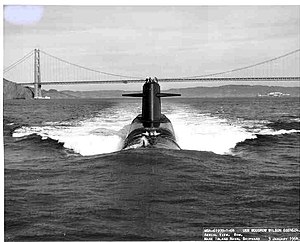
Back Lafayette-klas duikboot Afrikaans Třída Lafayette Czech Lafayette-Klasse German Clase Lafayette Spanish زیردریایی کلاس لافایت Persian Lafayette-luokka Finnish Classe Lafayette (sous-marin) French Classe Lafayette Italian ラファイエット級原子力潜水艦 Japanese 라파예트급 잠수함 Korean
 Lafayette-class submarine USS Woodrow Wilson
| |
| Class overview | |
|---|---|
| Name | Lafayette class |
| Builders | |
| Operators | |
| Preceded by | Ethan Allen class |
| Succeeded by | James Madison class |
| Built | 1961–1964 [1] |
| In commission | 1963–1994 [1] |
| Completed | 9 |
| Retired | 9 |
| Preserved | 1 (as training vessel) |
| General characteristics | |
| Type | Nuclear-powered ballistic missile submarine |
| Displacement | Surfaced: 7,325 long tons (7,443 t) Submerged: 8,251 long tons (8,383 t)[2] |
| Length | 425 ft (130 m) [1] |
| Beam | 33 ft (10 m) [1] |
| Draft | 28 ft 6 in (8.69 m) |
| Propulsion |
|
| Speed |
|
| Test depth | 1,300 feet (400 m)[2] |
| Complement | Two crews of 14 officers and 126 enlisted[2] |
| Armament | 16 Polaris A2/A3 or Poseidon C3 missiles, 4 × 21-inch (533 mm) torpedo tubes, 12 torpedoes[2] |
The Lafayette class of submarine was an evolutionary development from the Ethan Allen class of fleet ballistic missile submarine, slightly larger and generally improved. This class, together with the George Washington, Ethan Allen, James Madison, and Benjamin Franklin classes, composed the "41 for Freedom," the Navy's primary contribution to the nuclear deterrent force through the late 1980s. The James Madison and Benjamin Franklin classes are combined with the Lafayettes in some references.
- ^ a b c d e f g h i "SSBN-616 Lafayette-Class FBM Submarines" from the FAS Archived 2012-10-23 at the Wayback Machine
- ^ a b c d e f Friedman, Norman (1994). U.S. Submarines Since 1945: An Illustrated Design History. Annapolis, Maryland: United States Naval Institute. pp. 199–203, 244. ISBN 1-55750-260-9.